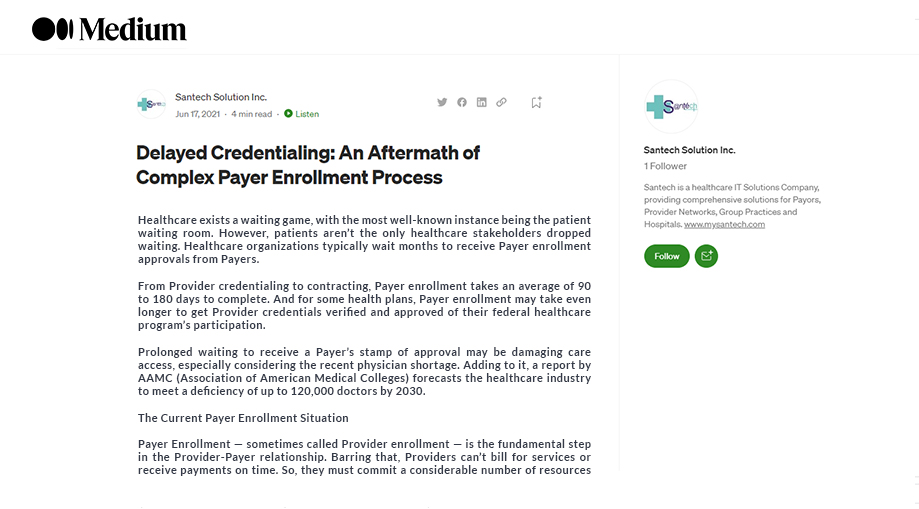Healthcare exists a waiting game, with the most well-known instance being the patient waiting room. However, patients aren’t the only healthcare stakeholders dropped waiting. Healthcare organizations typically wait months to receive Payer enrollment approvals from Payers.
From Provider credentialing to contracting, Payer enrollment takes an average of 90 to 180 days to complete. And for some health plans, Payer enrollment may take even longer to get Provider credentials verified and approved of their federal healthcare program’s participation.
Prolonged waiting to receive a Payer’s stamp of approval may be damaging care access, especially considering the recent physician shortage. Adding to it, a report by AAMC (Association of American Medical Colleges) forecasts the healthcare industry to meet a deficiency of up to 120,000 doctors by 2030.
The Current Payer Enrollment Situation
Payer Enrollment — sometimes called Provider enrollment — is the fundamental step in the Provider-Payer relationship. Barring that, Providers can’t bill for services or receive payments on time. So, they must commit a considerable number of resources to the Payer enrollment, time being the most exhausted resource. Each Payer demands specific forms, sent in particular formats, and with those forms often completed manually, it’s a tiresome grind that consumes valuable time for administrative staff and clinicians. They need to replicate many steps in the Payer enrollment process for each new Payer-Provider relationship. Actions often have to be redone even within a particular relationship due to constant updates and errors.
While completing the forms may seem simple, inconsistent processes used by health plans, clearinghouses, and other third parties involved bear many opportunities for failure.
In most cases, Payer Enrollment involves up to eight definite steps:
- Provider recruits and starts the credentialing process for a new clinician.
- The Provider informs the Payer that they are interested in credentialing.
- Provider manually completes different types of forms.
- Payer receives a Provider’s application.
- The 90-day-–plus review process begins.
- Payer performs a separate and distinct verification.
- Payer accepts Provider application.
- The process reiterates in two years to follow the NCQA (National Committee for Quality Assurance) credentialing standards.
The outcome of such a protracted process is a fragmented system with scarce to no assigned ownership of the information and defined roles involved. The manual tasks also hinder smooth transactions, from the demands for “wet signatures” to the utilization of a slow mail system to submit forms.
The elements mentioned above are the growing risk of “poor Provider data,” which complicates the Payer enrollment process by generating inconsistencies and redundancy. And with no single version of the truth to help as a dependable resource, repetitive processes and errors continue to pile up, requiring significant money and time.
Recognizing that Provider Data Management capabilities have remained relatively unchanged for the longest time, it is no surprise that existing processes often lack the flexibility needed at organizational, facility, and departmental levels, by a multi-facility hospital system. Throw state-specific regulatory requirements into the mix (i.e., for facilities across multiple states), and the status quo will not suffice for organizations needing to address issues and challenges that include:
- Lost revenue — Due to delays with Provider onboarding, credentialing, and/or Payer enrollment
- Perpetual backlogs — due to paper-based / manually intensive processes
- It is less than desirable concerning managing compliance and risk
- Often dependent on tribal knowledge instead of well-defined processes — unable to handle sudden growth
- Siloed Solutions — challenging to integrate with other systems, departments, and external data sources.
- Lack flexibility to support a hospital or practice’s future organizational structures
Common apps provided by different states and institutions such as CAQH aren’t solving delayed credentialing. It’s a problem that is only getting worse. The Providers are losing their chance to save millions of dollars by automating their administrative processes, including Payer enrollment.
How Can Technology Solve the Problem?
The Payer enrollment process’s inefficiencies and issues are not new, and a robust Provider data management (PDM) solution can alleviate Provider onboarding and enrollment challenges. I-Enroll is an enterprise premier PDM platform from Santech that puts Provider recruitment, Provider credentialing, Privileging, Provider re-appointments, and Payer enrollment processes under one umbrella.
Implementing I-Enroll can offer the following benefits:
- Streamlined credentialing across all organizational facilities with capabilities that include:
- Eliminating the need to rekey Provider data previously captured during the processing of Provider applications
- End-to-end automation of credentialing and verification workflows can support requirements specific to facilities, states, Provider types, and specialties.
- Paperless credentialing committee reviews and approvals.
- Simplified and cost-effective maintenance of credentials data, including continuous monitoring and reporting of sanctions.
- Establishment of an online high-performance credentials management center that serves all facilities centrally with the ability to coordinate privileging locally.
- A standard privileging process across the entire hospital system with options to customize or modify privileging rules according to local facility requirements or constraints.
- Automated privilege assignment, management, and inquiry.
- A direct Payer enrollment process leverages data collected and maintained by the credentialing process and automates the generation of Payer-specific enrollment forms.
- The ability to reduce the time and expense of maintaining multiple strategies and IT solutions.
- Seamless integration of Provider data with other HIS systems.
- The ability to capture and report metrics useful to continuously improving Provider Management capabilities.
- The ability to generate business value by taking advantage of technologies such as:
1. Automated workflow
2. Electronic signatures
3. Centralized document management
4. Role-based security
5. Automatic integration to third-party Provider verification services
The in-time enrollment of Providers into health plans is a critical element of maintaining an organization. Santech’s I-Enroll can help you reduce the paperwork burden, simplify compliance, expedite Provider enrollment, and enhance your healthcare organization’s profitability.
Ready to upgrade your Provider data management game? Connect with our experts.


